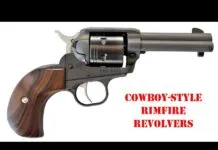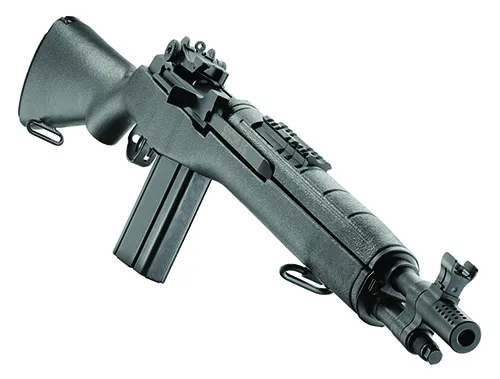In this day and time, the AR-15 rifle and its many clones are the number-one-selling rifle in the country. For personal defense, recreation and hunting, they are indisputably popular choices. But experienced shooters, veterans, and hunters often prefer the harder-hitting 308 Winchester rifle. The 30-caliber rifle hits hard, ranges far, and offers excellent stopping potential. Also, 308 Winchester ammunition is plentiful. With this in mind, we wanted to test two Springfield Armory rifles in the popular M1A configuration. One is the SOCOM version with a 16-inch barrel, and the other the Scout Squad with an 18-inch barrel. These are fast-handling rifles that outperform the AR or AK rifle at longer ranges. There is plenty of magazine capacity, and the rifles are proven in many years of use. But they are pricey, so we looked around for a similar rifle that we could shoot side by side with the Springfields, but which wouldn’t break the bank. The U.S. military never officially used the Tanker Garand, a short-barrel version of the M1 Garand, and the few experimental rifles of the type did not survive. However, enterprising gunsmiths modified Garand rifles into a similar configuration with an 18-inch barrel. Our used test rifle built by Federal Ordnance is a 30-06 Garand that uses en bloc clips to reload. How would this longer-action model compare in all-round survival and sporting use to the M1A short-barrel rifles? Better than you might have assumed.
| Fiocchi Extrema 150-grain SST | Springfield Armory Squad Scout | Springfield Armory SOCOM |
| Average Velocity | 2599 fps | 2557 fps |
| Muzzle Energy | 2250 ft.-lbs. | 2178 ft.-lbs. |
| Smallest Group | 1.9 in. | 2.0 in. |
| Average Group | 2.3 in. | 2.35 in. |
| Hornady Black 168-grain A-Max | Springfield Armory Squad Scout | Springfield Armory SOCOM |
| Average Velocity | 2540 fps | 2555 fps |
| Muzzle Energy | 2406 ft.-lbs. | 2435 ft.-lbs. |
| Smallest Group | 1.75 in. | 1.7 in. |
| Average Group | 2.1 in. | 2.0 in. |
| Black Hills 175-grain Match | Springfield Armory Squad Scout | Springfield Armory SOCOM |
| Average Velocity | 2430 fps | 2390 fps |
| Muzzle Energy | 2294 ft.-lbs. | 2219 ft.-lbs. |
| Smallest Group | 1.7 in. | 2.1 in. |
| Average Group | 1.8 in. | 2.2 in. |
| Fiocchi 150-grain FMJ | Federal Ordnance Tanker Garand |
| Average Velocity | 2670 fps |
| Muzzle Energy | 2374 ft.-lbs. |
| Smallest Group | 2.0 in. |
| Average Group | 2.4 in. |
| Hornady 168-grain A-Max | Federal Ordnance Tanker Garand |
| Average Velocity | 2600 fps |
| Muzzle Energy | 2522 ft.-lbs. |
| Smallest Group | 1.75 in. |
| Average Group | 2.25 in. |
| Winchester Super-X 180-grain Jacketed Soft Point | Federal Ordnance Tanker Garand |
| Average Velocity | 2598 fps |
| Muzzle Energy | 2697 ft.-lbs. |
| Smallest Group | 2.3 in. |
| Average Group | 2.5 in. |
Springfield Armory M1A Scout Squad FDE AA9120 7.62 NATO, $1455
GUN TESTS GRADE: A

| Action | Gas-operated semi-automatic |
| Overall Length | 40.33 in. |
| Overall Height (w/o magazine) | 4.6 in. |
| Maximum Width | 2.6 in. |
| Weight Unloaded | 8.9 lbs. |
| Capacity | 5-, 10-, 20-, 25-round magazines |
| Barrel | 18.0 in. 6-groove 1:11 twist, carbon steel, muzzle brake |
| Buttstock | Flat dark earth synthetic |
| Fore-end | FDE synthetic |
| Length of Pull | 13.5 in. |
| Trigger Style | Two-stage National Match |
| Trigger-Pull Weight | 5.75 lbs. |
| Magazine | (1) 10-round detachable box |
| Magazine Release | Spring-loaded lever |
| Bolt Release | Receiver mounted |
| Rear Sight | Military .0690 aperture, MOA adj. for windage & elevation |
| Front Sight | 0.62 in. blade |
| Receiver Scope Provisions | Rail in front of receiver, side mount |
| Warranty | Limited lifetime |
| Telephone | (800) 680-6866 |
| Website | Springfield-Armory.com |
| Made In | USA |
This rifle is chambered for the 7.62x51mm NATO round, commercially loaded as the 308 Winchester. The M1A is a semi-automatic version of the M14 in some ways and in others a modern development of the M1A match-rifle version of the M14. The rifle features a gas-operated action similar in principle to the M1 Garand developed in 1936 and used in World War II and Korea. As the rifle fires, a portion of the gas generated is tapped to a gas tube. The force of this gas is used against the operating rod to cycle the action. As first envisioned, the M14 was intended to replace and perform the duties of the M1 Garand, M1 .30 carbine, M3 submachine gun and Browning Automatic rifle. While it did many things well, it did not replace these weapons overnight, or ever. When Springfield Armory introduced the M1A rifle, civilians had a chance to use and appreciate the M14-like rifle. Today, we have variants the U.S. military never had. We don’t know if Springfield Armory based the Scout Squad on the semi-mythical Tanker Garand, but perhaps they did. In any case, they designed a fast-handling M1A variant.
The Scout Squad features a rifle shortened from the M1A’s 22-inch barrel to 18 inches. The flash hider is more of a muzzle brake. While all M1A rifles feature a mount to adapt a side-mounted rifle scope, the Scout Squad features a barrel rail for mounting optics.
Also, the rifle features a two-stage trigger. The trigger is clean enough at 5.75 pounds for good offhand and benchrest shooting. The rifle is supplied with a protected post front sight and adjustable-aperture rear. The rifle features a chrome-moly barrel with a 1:11-inch rifling twist.
The rifle accepts a detachable magazine, with 10- or 20-round magazines being most common, but magazines of 5, 15, and 25 cartridges are available. For this test, every 308 magazine used was Springfield Armory. We have not experienced the best reliability with anything other than Springfield-marked magazines.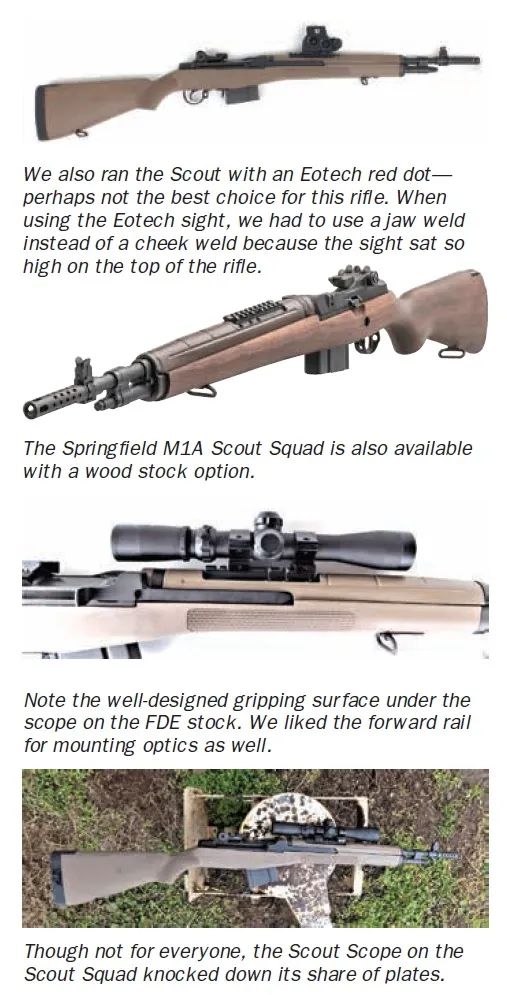
The M1A features a trigger-guard-mounted safety that is pressed forward to fire. Some of the raters used the thumb to move the safety because these are often quite stiff. We didn’t feel much difference in pressure needed to operate the safeties. At this point, we should mention these rifles have a free-floating firing pin. Never allow the bolt to slam home on a loaded chamber. The firing pin may take a run and ignite the cartridge. Always insert a loaded magazine, rock it into place, and then either release the bolt or rack the bolt to let it run forward. This slows the bolt down as it properly loads a cartridge from the magazine. The Garand is the same type of action and should also be loaded only from the magazine, not single loaded. The 18-inch-barrel M1A is a bold move for Springfield that has been well received since its introduction. After all, the M1A enjoys a great reputation for reliability and accuracy, and the short rifle is a different type of firearm for a different niche.
The rifle was tested with a total of four different loads. The majority load used was fired during the combat and tactical course. This was the Winchester 147-grain full metal jacket. We also used Fiocchi’s 150-grain SST as an example of a hunting load. The Hornady Black 168-grain A-Max is a good example of a tactical round. As an example of a match load, we used the Black Hills Ammunition 175-grain round. We used the Winchester FMJ load in combat shooting, firing 100 cartridges in each rifle. The JSP loads were fired for accuracy from the bench rest. We also fired a full magazine of the Fiocchi 150-grain SST offhand.
To start, we lubricated the bolt and critical areas and loaded five magazines with Winchester FMJs. We fired the rifle at human silhouette targets at 25, 50, and 100 yards, as well as a steel reaction plate at 100 yards. We found the rifle comes to the shoulder quickly and moves quickly to cover targets. Recoil is there with the 308 round, but the gas-operated rifle generates less felt recoil than similar-weight bolt-action rifles. The rifle offered a rapid follow-up shot. It wasn’t difficult to fill the target full of holes quickly at 25 yards. At 50 yards, we slowed down a little, and at 100 yards, firing a 5- to 8-inch offhand group takes time, attention to the trigger press, and a good sight picture. But the rifle would do it if we did our part.
At one point, we fitted the rifle with a Leatherwood Hi Lux Scout Scope. This isn’t an expensive unit ($140 at Brownells.com), but the rater using it has enjoyed good service with the optic. This 2×7-32mm scope has a long eye relief like a pistol scope. While we found it useful, it should be used only at the lowest resolution in snap shooting or fast shooting. An advantage is that the Scout Scope may be used with both eyes open at the lowest setting. After some acclimation, we found the Hi Lux Scout Scope could be fast at 50 yards or so, but some of the raters preferred iron sights. Most of the shooting was done with iron sights. However, firing off the benchrest, we found that groups could be improved using the highest setting on the Leatherwood Hi Lux. It just takes getting used to. We also briefly mounted an Eotech red dot. This sight is a good performer, but with the M1A demands a chin weld rather than a cheek weld when using this type of sight, not ideal for most shooters.
We started by firing 100 rounds of Winchester FMJs and 20 rounds of Fiocchi jacketed soft points. There were no failures to feed, chamber, fire, or eject. Firing at the steel reaction targets at 100 yards, we seldom missed. The sights offer 1-minute-of-angle movement per click, and the front post offered good visibility, although it would subtend a very small target at 100 yards. In firing for accuracy, we used the Black Hills, Fiocchi, and Hornady JSP loads. Shot from a solid benchrest with iron sights, the rifle exhibited good accuracy for a short-barrel 308 self loader. The various loads averaged 2.0 inches, and consistent.
Our Team Said: There wasn’t really anything we did not like about this rifle. We liked the SOCOM more, however.
Springfield Armory M1A SOCOM 16 AA9626 7.62 NATO/308 Win., $1799
GUN TESTS GRADE: A (OUR PICK)

| Action | Gas-operated semi-automatic |
| Overall Length | 37.25 in. |
| Overall Height (w/o magazine) | 4.6 in. |
| Maximum Width | 2.6 in. |
| Weight Unloaded | 8.9 lbs. |
| Capacity | 5-, 10-, 20-, 25-round magazines |
| Barrel | 16.25 in., 6-groove carbon steel, 1:11 twist |
| Buttstock | Black synthetic |
| Fore-end | Black synthetic |
| Trigger Style | Two-stage military |
| Trigger Weight | 5.5 lbs. |
| Magazine | (1) 10-round detachable box |
| Magazine Release | Lever |
| Bolt Release | Receiver Mounted |
| Rear Sight | Ghost Ring .135 Aperture, MOA adj. for windage & elevation |
| Front Sight | XS post w/tritium insert, 0.125 blade |
| Receiver Scope Provisions | Rail in front of receiver/side mount |
| Warranty | Limited lifetime |
| Telephone | (800) 680-6866 |
| Website | Springfield-Armory.com |
| Made In | USA |
With the SOCOM, you get a 16-inch-barrel rifle with more of a muzzle brake than a flash hider. The front sight also features a narrow tritium insert. The Scout Squad shooter may fit an XS Sights front blade for $63 to come on par with the SOCOM. We liked the balance and fit and feel of the SOCOM rifle. We did not attempt to mount an optic on this rifle.
In common with the other M1A, the bolt was easy enough to rack and all functions were positive. Each rifle had a stiff safety, but after a few dozen manipulations, the safety was a bit easier to move. The magazines slid in properly and locked in place as designed. The magazines were not difficult to load to full capacity.
Firing the SOCOM offhand, we felt little difference between this rifle and the 18-inch-barrel Scout Squad. We did not fire in dim light; however, in certain firing sessions when clouds covered the sun, the sky was darker and we detected some muzzle flash with the shorter rifle. This was also true of the other M1A rifle but was slightly more pronounced with the SOCOM. This was most noticeable with the Fiocchi hunting load, but was almost nonexistent with the Hornady Black in either rifle. Fired offhand in rapid fire at the same ranges and the same type of targets as the Scout Squad, the SOCOM presented no difficulty getting hits. The slightly shorter sight radius seemed no deterrent to getting fast hits. In fact, we found the SOCOM faster in moving between targets and getting rapid hits out to 100 yards. Fired at the steel gong at a 100 yards, the rifle delivered excellent function. We had no difficulty sighting the rifle in properly and delivering good results in fast-paced drills. We rated the rifle a notch above the Scout Squad in this regard, which was counterintuitive but true. We felt the SOCOM would surely be easier to stow, which it was, but it was also easier to get fast hits with. In firing for absolute accuracy the SOCOM exhibited good practical accuracy. With the Hornady Black load, it was more accurate than the Scout Squad, but not with the other two loads.
Our Team Said: We feel that if you wish to own and use a short-barrel M1A1 that handles quickly, get the SOCOM. If you value greater accuracy, get the full-size 22-inch barrel M1A.
Federal Ordnance M1 Garand Tanker Garand 30-06 Springfield, $775 (used)
GUN TESTS GRADE: B

| Action | Gas-operated semi-automatic |
| Overall Length | 37.5 in. |
| Overall Height | 4.75 in. |
| Maximum Width | 4.75 in. |
| Weight Unloaded | 8.0 lbs. |
| Capacity | 8 |
| Barrel | 18.0 in. |
| Trigger Style | Two-stage military |
| Trigger Weight | 6.75 lbs. |
| Buttstock | Wood |
| Fore-end | Wood |
| Magazine | En bloc clip |
| Magazine Release | Manual |
| Bolt Release | Manual |
| Rear Sight | Aperture |
| Front Sight | Blade |
| Receiver Scope Provisions | None |
| Warranty | None |
| Telephone | NA |
| Website | NA |
| Made In | USA |
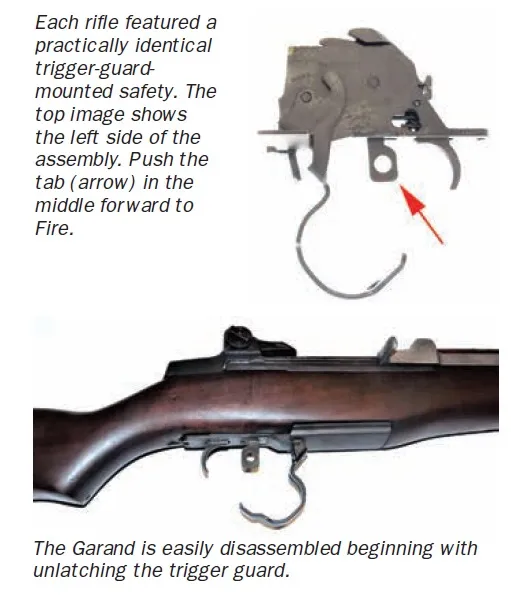
All modern Tanker Garands are custom or small-shop production. The rifle features a barrel shortened to 18 inches. The result is a lighter rifle at 8.0 pounds, versus 9.5 pounds for the full-size version. Other than that, the rifle operates and fires in the same manner as the M1 Garand rifle.
The Garand is gas operated, and the resemblance to the M1A is obvious. The greatest difference is that the Garand uses an en bloc clip, a sheet-metal assembly loaded with eight cartridges. To load the rifle, the shooter locks the bolt to the rear. Push the loaded clip into the Garand’s internal magazine. As the clip is loaded, the follower is pressed down and the clip locks in place. The thumb has pressed the clip into place. The outside of the hand then moves the operating handle slightly to the rear and quickly moves away, releasing the bolt to fly forward and load the rifle. The safety is in the same location as the M1A previously discussed. The rifle is fired, and after the eighth round, the bolt locks to the rear and the en block clip is ejected with a distinctive ping.
The Tanker Garand features good wood-to-metal fit. The finish on the parts and final fitting seemed good. The trigger is lighter than either of the Springfield rifles, but then the parts have been around a long time. The last military Garand was manufactured in 1957, to the best of our knowledge. The rifle seemed to be well put together and did not look like a parts gun, which of course it is.
We collected three loads for firing and accuracy testing. First came the affordable Fiocchi 30-06 Springfield 150-grain FMJ. This load was used in firing 96 rounds off hand, consisting of 12 en bloc clips loaded with eight rounds. Next came the M1 Garand load by Hornady, using the 168-grain A-Max and the Winchester Super-X 180-grain JSP. The Garand, the raters noted, handles differently than the M1A. Other than the difference in loading, the balance is different. The en bloc clip is easy to use well, but it operates differently than the 20-round magazine of the M1A. The Garand has a different balance because it doesn’t have a protruding magazine. If carried in a rack or behind the truck seat, the Tanker Garand is less obtrusive.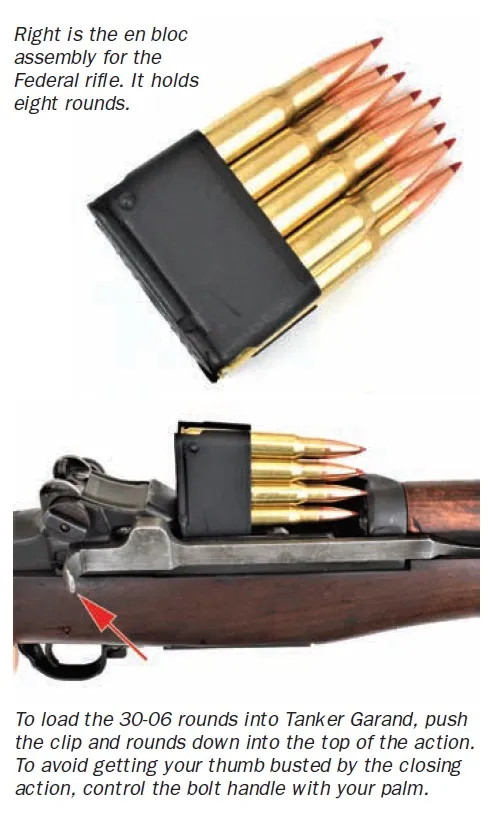
In firing, we loaded the rifle and worked over targets on the same course as the M1A. There was greater recoil, not by a great margin, but noticeable compared to the M1A. The Garand has a shorter length of pull and it doesn’t have a recoil pad. The Garand simply pushes a bit more horsepower. In firing, control was excellent for those using proper technique. After a bit of acclimation, our shooters made both rapid hits and rapid reloads. The drill to reload is different, of course. The shooter takes the rifle down from the shoulder to push in the en bloc clip loaded with cartridges. The M1A may be reloaded from the shoulder if you have long arms and practice. Eight rapid, accurately delivered 30-06 cartridges will be up to the task of stopping most threats, man or beast. With practice, the reload is fast and sure, but for those who do not master the drill, getting an M1 thumb — the powerful bolt pushing the thumb into the chamber — is more than possible and not very pleasant.
Fast hits were possible and comparable to the M1A. Firing at man-sized targets and steel plates, the results were good to 100 yards. The Garand handles well, and it is perhaps underrated for close-quarters combat. We ran across one shortcoming, simply a consideration, and one which the owner will address at a later date. The rear aperture is the proper sight for a standard Garand. When the barrel is shortened, the front post assembly is moved closer to the rear peep sight. To our eyes, the sight picture was a bit too tight. A gunsmith will have to remove the rear sight and very slightly drill it out.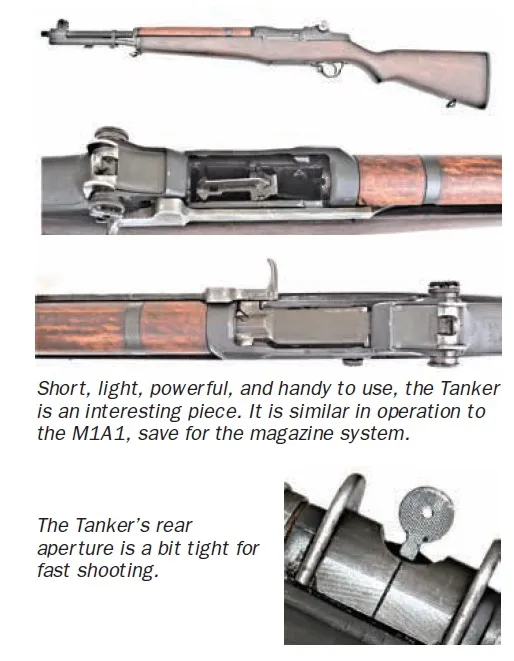
This sight may have been an impediment in fast reactive shooting, but just the same, the Tanker Garand handled very quickly. The natural balance was excellent. One of the raters said that while recoil was greater, the Tanker Garand and the SOCOM rifle gave up little in rapid handling to the M1 30 Carbine. We did not all agree with that comparison, but the Tanker Garand is a fast-handling rifle. In firing off the benchrest, the Tanker Garand’s small aperture was perhaps more of an asset than an impediment, although time between aiming each shot was greater. The rifle turned in credible groups. The Fiocchi loading averaged just over 2 inches. The rifle did not like the heavy 180-grain JSP as much, with a 2.5-inch 100-yard group. The Hornady Garand load gave excellent accuracy, with a group of 1.75 inches for five shots.
Our Team Said: As it turned out, the Tanker Garand is a good shooter, fast shooting, and reliable. The two Springfields outclass this 30-06, but if you can find this Federal Ordnance M1 Garand as a used product in good shape, it will often be available at a several-hundred-dollar discount under the others. That alone might make it Your Pick.
Written and photographed by Gun Tests Staff, using evaluations from Gun Tests team testers.






